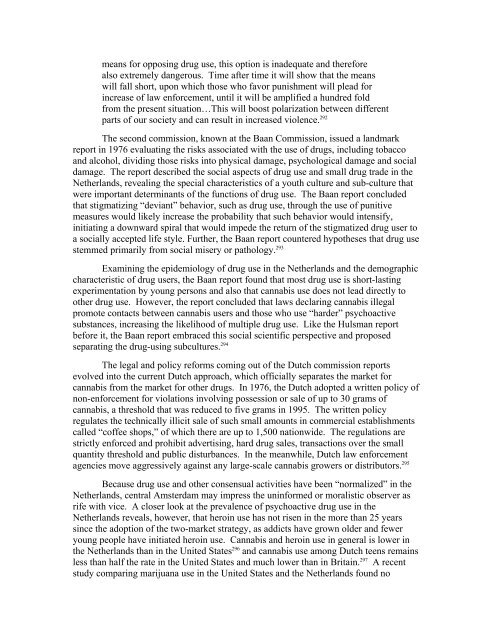Effective Drug Control: Toward A New Legal Framework
Effective Drug Control: Toward A New Legal Framework
Effective Drug Control: Toward A New Legal Framework
You also want an ePaper? Increase the reach of your titles
YUMPU automatically turns print PDFs into web optimized ePapers that Google loves.
means for opposing drug use, this option is inadequate and therefore<br />
also extremely dangerous. Time after time it will show that the means<br />
will fall short, upon which those who favor punishment will plead for<br />
increase of law enforcement, until it will be amplified a hundred fold<br />
from the present situation…This will boost polarization between different<br />
parts of our society and can result in increased violence. 292<br />
The second commission, known at the Baan Commission, issued a landmark<br />
report in 1976 evaluating the risks associated with the use of drugs, including tobacco<br />
and alcohol, dividing those risks into physical damage, psychological damage and social<br />
damage. The report described the social aspects of drug use and small drug trade in the<br />
Netherlands, revealing the special characteristics of a youth culture and sub-culture that<br />
were important determinants of the functions of drug use. The Baan report concluded<br />
that stigmatizing “deviant” behavior, such as drug use, through the use of punitive<br />
measures would likely increase the probability that such behavior would intensify,<br />
initiating a downward spiral that would impede the return of the stigmatized drug user to<br />
a socially accepted life style. Further, the Baan report countered hypotheses that drug use<br />
stemmed primarily from social misery or pathology. 293<br />
Examining the epidemiology of drug use in the Netherlands and the demographic<br />
characteristic of drug users, the Baan report found that most drug use is short-lasting<br />
experimentation by young persons and also that cannabis use does not lead directly to<br />
other drug use. However, the report concluded that laws declaring cannabis illegal<br />
promote contacts between cannabis users and those who use “harder” psychoactive<br />
substances, increasing the likelihood of multiple drug use. Like the Hulsman report<br />
before it, the Baan report embraced this social scientific perspective and proposed<br />
separating the drug-using subcultures. 294<br />
The legal and policy reforms coming out of the Dutch commission reports<br />
evolved into the current Dutch approach, which officially separates the market for<br />
cannabis from the market for other drugs. In 1976, the Dutch adopted a written policy of<br />
non-enforcement for violations involving possession or sale of up to 30 grams of<br />
cannabis, a threshold that was reduced to five grams in 1995. The written policy<br />
regulates the technically illicit sale of such small amounts in commercial establishments<br />
called “coffee shops,” of which there are up to 1,500 nationwide. The regulations are<br />
strictly enforced and prohibit advertising, hard drug sales, transactions over the small<br />
quantity threshold and public disturbances. In the meanwhile, Dutch law enforcement<br />
agencies move aggressively against any large-scale cannabis growers or distributors. 295<br />
Because drug use and other consensual activities have been “normalized” in the<br />
Netherlands, central Amsterdam may impress the uninformed or moralistic observer as<br />
rife with vice. A closer look at the prevalence of psychoactive drug use in the<br />
Netherlands reveals, however, that heroin use has not risen in the more than 25 years<br />
since the adoption of the two-market strategy, as addicts have grown older and fewer<br />
young people have initiated heroin use. Cannabis and heroin use in general is lower in<br />
the Netherlands than in the United States 296 and cannabis use among Dutch teens remains<br />
less than half the rate in the United States and much lower than in Britain. 297 A recent<br />
study comparing marijuana use in the United States and the Netherlands found no
















